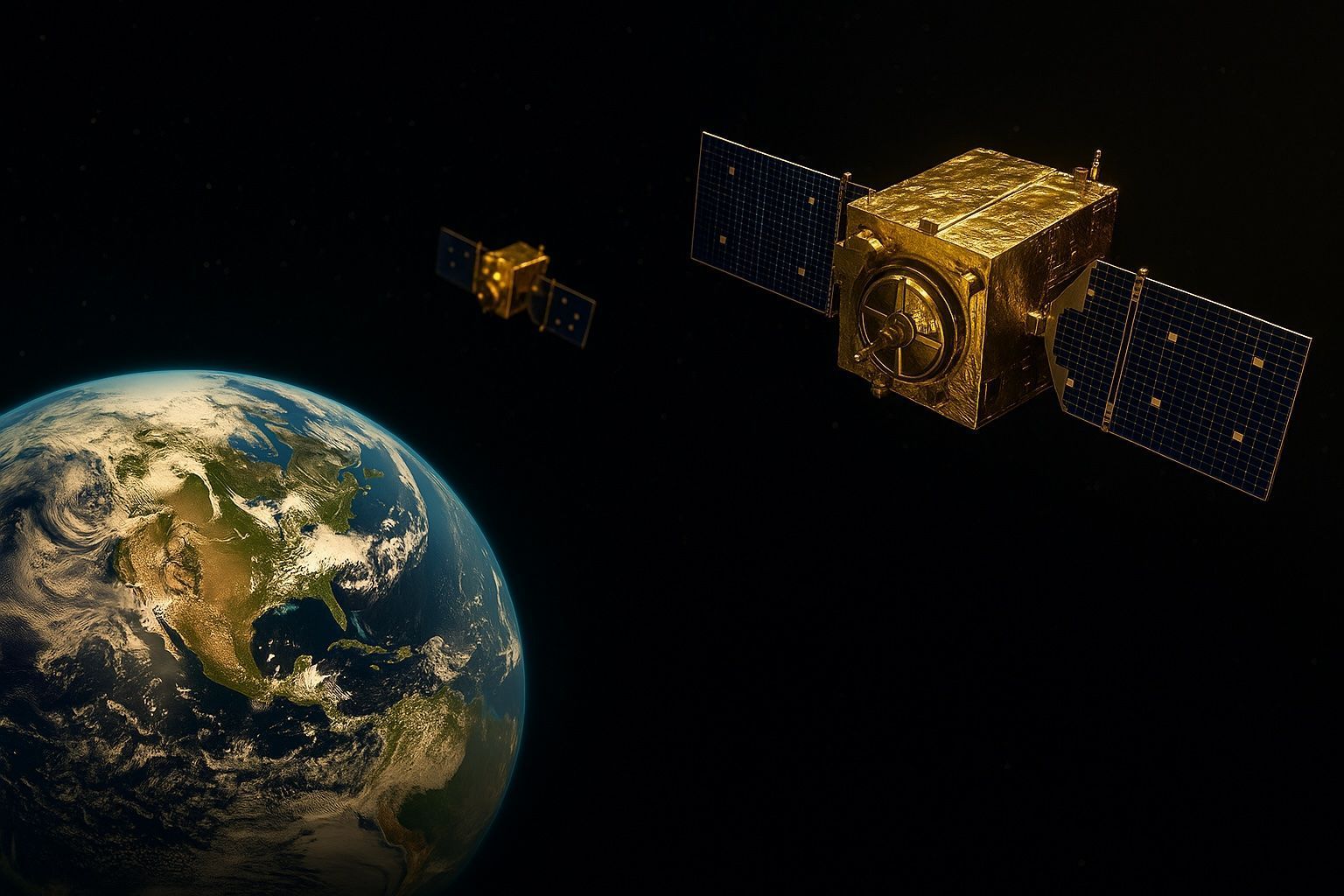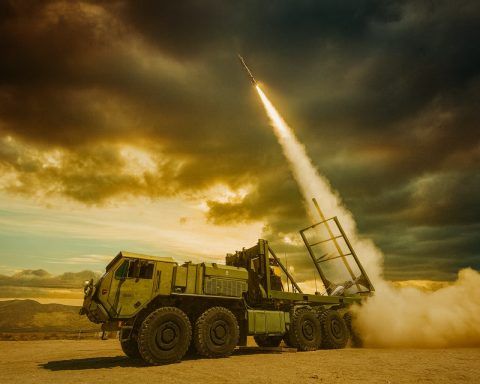- GSSAP-1 and GSSAP-2 were launched on July 28, 2014 aboard a Delta IV M+(4,2) from Cape Canaveral, accompanied by the ANGELS experimental satellite.
- The GSSAP satellites operate in near-geosynchronous orbit roughly 35,900 km (22,300 miles) above Earth and function as a “neighborhood watch” for the GEO belt, providing space situational awareness to USSPACECOM.
- Built by Northrop Grumman on the GeoStar-1 bus, GSSAP satellites are three-axis stabilized and carry high-resolution optical sensors capable of rendezvous and proximity operations with other GEO objects.
- Each GSSAP spacecraft carries limited onboard propellant, meaning its maneuvering life spans only a few years before it must be retired to a graveyard orbit, such as GSSAP-2 in August 2023.
- Data from GSSAP is downlinked via the Air Force Satellite Control Network to Schriever Space Force Base, where Space Delta 6 processes observations for USSPACECOM.
- GSSAP-3 and GSSAP-4 were launched on August 19, 2016 aboard a Delta IV M+(4,2) booster and achieved operational status by late 2017.
- GSSAP-5 and GSSAP-6 launched on January 21, 2022 aboard an Atlas V 511 (USSF-8) mission, expanding the constellation to six satellites by mid-2022.
- The program has faced international scrutiny for close approaches to foreign GEO satellites, with Russian data noting approaches within 10 kilometers to at least five Russian GEO satellites between 2016 and 2018 and Chinese analysts criticizing such proximity in 2023 spacesafetymagazine reports.
- The Space Force plans to add GSSAP-7 and GSSAP-8 around 2024 and 2027, with potential single-satellite launches rather than paired deployments.
- Silent Barker (NROL-107) began launching in September 2023 as a GEO-wide surveillance system that complements GSSAP, while in-orbit servicing and refueling research aims for sustained space maneuver capabilities by 2028.
High above Earth, in the crowded expanse of geosynchronous orbit (GEO) some 22,300 miles up, a set of American satellites quietly keeps watch. These are the Geosynchronous Space Situational Awareness Program (GSSAP) satellites – often dubbed “neighborhood watch” satellites – and they form a covert but crucial line of defense in space. Born in secrecy and now a linchpin of U.S. Space Force operations, GSSAP’s “silent sentinels” monitor other spacecraft, guard vital national assets, and exemplify the new era of space surveillance. What follows is an in-depth look at GSSAP’s origins, missions, capabilities, and its role in securing America’s dominance in the high frontier.
Program Origin and Background
The GSSAP program began under a veil of classification in the early 2010s as the U.S. Air Force sought better ways to surveil objects in GEO – the orbital ring where critical satellites for communications, navigation, and missile warning reside. The existence of GSSAP was first publicly revealed in 2014 after years of covert development [1]. In July 2014, the Air Force launched the first two operational GSSAP satellites into near-geosynchronous orbit, together with a small experimental satellite known as ANGELS (Automated Navigation and Guidance Experiment for Local Space) [2] [3]. According to Air Force Secretary Deborah Lee James, these spacecraft would “enhance the nation’s ability to monitor and assess events… [creating] a space neighborhood watch capability” [4]. This concept of a “neighborhood watch” in space captures GSSAP’s core purpose: to closely watch over the “neighborhood” of GEO where U.S. and allied satellites reside, and to notice any unusual or threatening behavior by other objects.
From the start, military leaders framed GSSAP as a response to a changing space environment. By 2014, space was becoming “increasingly congested, contested and competitive,” in James’ words [5]. The head of Air Force Space Command at the time, Gen. William Shelton, stressed that while the U.S. “supports the peaceful use of space for all countries,” it was “necessary to increase our ability to detect and attribute any threatening or disruptive actions” in orbit [6]. In essence, GSSAP was born to fill a critical gap: providing persistent, up-close surveillance of objects in GEO, something ground-based radars and telescopes struggle to do at such altitudes. Initially an Air Force program (code-named “Hornet” in some circles [7]), GSSAP later transitioned under the U.S. Space Force upon that service’s establishment in 2019. Its early launches in 2014 marked a significant milestone – the first dedicated U.S. “watchdog” satellites in GEO, giving the U.S. Strategic Command (and later U.S. Space Command) a new set of eyes in high orbit.
Purpose and Objectives of GSSAP
The primary mission of GSSAP is space situational awareness (SSA) in the geosynchronous belt – in simpler terms, tracking and characterizing other objects orbiting in GEO. The satellites serve as space-based sensors for the U.S. Space Surveillance Network, feeding data to U.S. Space Command to improve the catalog of space objects and inform operational decision-making [8]. Because they orbit near GEO, GSSAP satellites have a clear, unobstructed vantage point for observing satellites at that altitude, unhindered by weather or atmospheric distortion that limit ground-based sensors [9]. This vantage allows for improved tracking accuracy and the ability to detect subtle changes in an object’s orbit or status [10].
Beyond simply watching from afar, GSSAP satellites can perform rendezvous and proximity operations (RPO) – in other words, they can maneuver to approach other resident space objects of interest [11]. This capability enables up-close inspection and characterization of satellites or debris, which is invaluable for anomaly resolution (for example, diagnosing why a satellite might be malfunctioning) and for monitoring potentially hostile acts in orbit [12]. If a satellite in GEO starts behaving oddly or an unrecognized object appears, a GSSAP “watchdog” can fly over to take a closer look. Data collected – likely high-resolution images and other observations – helps analysts determine what that object is and whether it poses a threat. In essence, GSSAP provides “eyes-on” confirmation of activities in GEO that would otherwise be difficult or impossible to discern from Earth [13].
Another key objective of GSSAP is supporting spaceflight safety. By refining orbital data and characterizing objects, GSSAP contributes to more timely and accurate orbit predictions, improving collision avoidance for satellites in the heavily used GEO belt [14]. The program has been described as a space “neighborhood watch” that not only detects adversary behavior but also helps prevent accidents. GSSAP data is integrated with the broader Space Surveillance Network to issue conjunction warnings (alerts when two objects might collide) and to maintain the master catalog of man-made objects in orbit. In summary, the purpose of GSSAP is to give the U.S. a continuous, reliable set of “guardians” in geosynchronous orbit – enhancing awareness, accountability, and safety in that critical domain.
Technical Specifications and Capabilities of GSSAP Satellites
The GSSAP satellites are relatively small, maneuverable spacecraft built for stealthy surveillance duties in the GEO environment. Each satellite operates in a near-geosynchronous orbit around 35,900 km (22,300 miles) above Earth [15]. Rather than maintaining a fixed position like a typical GEO communications satellite, GSSAP satellites can drift north-south or east-west along the GEO belt and adjust their orbits as needed. This allows them to periodically reposition and approach other satellites or debris in GEO. According to official fact sheets, GSSAP vehicles are “space-based [SSA] capability operating in the near-geosynchronous orbit regime” and function as a dedicated sensor node in space [16]. Critically, they have the ability to conduct Rendezvous and Proximity Operations, meaning they can rendezvous with another object at close range under controlled conditions [17]. This RPO capability is central to their design – it requires precise propulsion control, navigation, and automation to safely maneuver near another satellite without causing a collision [18].
Each GSSAP satellite was manufactured by Northrop Grumman (formerly Orbital ATK), built on a lightweight GeoStar-1 satellite bus optimized for GEO operations [19]. They are three-axis stabilized (meaning they can point instruments stably at targets) and are powered by deployable solar arrays [20]. The satellites carry a suite of sensors, reportedly including high-resolution optical cameras for imaging other objects [21]. These electro-optical sensors allow GSSAP to take detailed pictures or video of nearby satellites, potentially resolving features or detecting damage. In addition, some analyses suggest they may host electronic surveillance instruments to collect signals or other data, although specific capabilities remain classified [22]. The combination of optical and other sensors gives GSSAP a multifaceted ability to “inspect” a target spacecraft – observing its appearance, motion, or emissions to glean information about its status and function.
A notable aspect of GSSAP’s capability is its maneuverability – but this is constrained by on-board fuel. The satellites use thrusters to change orbits and conduct proximity operations, expending finite propellant each time. Operators must therefore use fuel strategically. “We have to think in terms of months and years of where they’re going to maneuver these GSSAP satellites,” explained Lt. Gen. John Shaw of U.S. Space Command, highlighting that each satellite carries a limited fuel supply [23]. Once a GSSAP runs out of propellant, it can no longer maneuver and must be retired to a disposal orbit. This finite fuel life (on the order of several years) means GSSAP cannot chase every object at will – choices are made to prioritize the most important surveillance targets. The Space Force has acknowledged this lifespan limitation, noting that historically once a GSSAP satellite is out of fuel, “it’s done – there is no way to refuel in space” under current operations [24]. This constraint is driving interest in future on-orbit refueling or servicing (discussed later).
In terms of communications and control, GSSAP satellites downlink their data via the global Air Force Satellite Control Network (AFSCN) ground station system [25]. The information is sent to Schriever Space Force Base in Colorado, where Space Delta 6 operates the satellites and processes their observations [26]. From there, data is integrated into U.S. Space Command’s systems. Notably, GSSAP satellites are designed to be stealthy in their movements – while not “invisible,” they can shift orbits in ways that might not be immediately obvious to adversaries tracking objects from Earth. Their relatively small size and potentially low reflectivity make them faint on optical telescopes, and their orbital adjustments can be subtle. This stealth, combined with their agility and sensor payload, makes GSSAP a uniquely capable space surveillance platform – essentially a set of orbital inspectors that can go where ground-based sensors cannot, to closely scrutinize objects of interest in GEO.
Operational History and Key Launches
Since its inception, the GSSAP program has deployed multiple satellites in a series of launches and has accumulated an operational track record as America’s “neighborhood watch” in space. The inaugural GSSAP mission took place on July 28, 2014, when a United Launch Alliance Delta IV rocket from Cape Canaveral delivered GSSAP-1 and GSSAP-2 into near-geosynchronous orbit [27]. These first two satellites (also called Space Vehicle 1 and 2) were declared initially operational in September 2015 [28]. Even as they underwent testing, they were reportedly pressed into early service to address urgent space monitoring needs [29], a testament to how critical their capabilities were seen from the start. Following their successful debut, a second pair of GSSAP satellites (SV-3 and SV-4) was launched on August 19, 2016 – also on a Delta IV M+(4,2) booster – and were operational by late 2017 [30]. These four satellites formed the core GSSAP constellation for several years, providing routine surveillance of the GEO belt.
After the establishment of the U.S. Space Force, the program saw another expansion. On January 21, 2022, the fifth and sixth GSSAP satellites were launched aboard an Atlas V rocket (mission USSF-8) into GEO, adding further coverage and resiliency to the system [31] [32]. By mid-2022, GSSAP was a six-satellite constellation (though not all six were necessarily operational at once, as the oldest ones approached end-of-life). Table 1 below summarizes the key GSSAP launch missions and their details:
Table 1: Key GSSAP Missions and Launch Dates
| Launch Date | GSSAP Satellites Deployed | Launch Vehicle (Mission) |
|---|---|---|
| July 28, 2014 | GSSAP-1 and GSSAP-2 (SV-1 & SV-2) | Delta IV M+(4,2) (AFSPC-4) [33] |
| Aug 19, 2016 | GSSAP-3 and GSSAP-4 (SV-3 & SV-4) | Delta IV M+(4,2) (AFSPC-6) [34] |
| Jan 21, 2022 | GSSAP-5 and GSSAP-6 (SV-5 & SV-6) | Atlas V 511 (USSF-8) [35] |
Each of these launches took place from Cape Canaveral, Florida, and in each of the first two missions the GSSAP satellites were deployed in pairs. (Notably, the 2014 Delta IV launch also carried the single ANGELS experimental microsatellite as a co-passenger [36].) The use of pairs was a cost-effective way to populate the constellation quickly, essentially getting two inspectors to GEO with one rocket. By launching in 2014, 2016, and 2022, the Space Force ensured that as older satellites aged or exhausted fuel, newer ones were available to continue the mission.
Throughout their operational history, GSSAP satellites have been actively patrolling the GEO belt and have undertaken a number of notable surveillance missions. U.S. officials keep specific operational details classified, but some information has emerged publicly. For example, one of the 2016-launched satellites (cataloged as USA-270) was observed to approach two Chinese satellites in GEO to examine them more closely [37]. In fact, Chinese researchers reported that over a two-year period, they noted 14 close approaches by U.S. inspector satellites to Chinese spacecraft in high orbit [38]. These close passes, presumably conducted by GSSAP vehicles, demonstrate the program’s ability to obtain up-close intelligence on foreign satellites. GSSAP has likely been used to inspect not only Chinese assets but also Russian GEO satellites and even derelict objects or unidentified space debris, as needed, to gather information.
By providing this on-demand inspection capability, GSSAP has been instrumental in several real-world space events. For instance, if a satellite unexpectedly breaks apart or a mysterious object appears near a critical U.S. satellite, GSSAP can be tasked to investigate. The satellites have also contributed routine tracking data to improve the orbital catalog – especially for high-altitude objects that are hard to track from the ground. Data from GSSAP has enhanced detection of small debris or pinpointed the exact orbits of satellites that perform maneuvers. This has improved overall SSA for the GEO regime [39].
As of 2023, some of the original GSSAP satellites have started to reach end-of-life. After roughly nine years on orbit, one of the inaugural satellites was recently retired. In August 2023, Space Systems Command announced that GSSAP-2 (the second satellite from the 2014 launch) had been decommissioned and boosted to a graveyard orbit after exceeding its design life [40]. This marked the first deactivation of a GSSAP spacecraft, making way for newer replacements. (Curiously, some reports suggested GSSAP-1 had also been quietly moved to a graveyard orbit earlier, but the official confirmation was about GSSAP-2 [41].) With one or two of the oldest “neighborhood watch” sentinels now retired, the constellation at present consists of four to five active GSSAP satellites, covering the GEO belt with strategic spacing. The Space Force has stated that the newer satellites (like those launched in 2022) achieved initial operational capability quickly – by April 2022 for GSSAP-5 and 6 [42] – and are fully integrated into operations.
Role in U.S. Space Command and Broader Space Situational Awareness
GSSAP plays a pivotal role in U.S. Space Command’s space domain awareness mission, plugging a critical gap in the Space Surveillance Network (SSN). U.S. Space Command (USSPACECOM) is the combatant command responsible for global space operations, which includes tracking all objects in orbit and protecting U.S. and allied space assets. The GSSAP satellites serve as dedicated orbital sensors for USSPACECOM, providing an on-orbit perspective that complements ground-based radars and telescopes [43]. Essentially, they are mobile observation posts in space, reporting on activities in GEO in near-real-time. Data from GSSAP is fed into the Combined Space Operations Center (CSpOC) and other command-and-control nodes that maintain the catalog of space objects and issue safety alerts.
One of the biggest advantages GSSAP provides to Space Command is persistence and precision in GEO surveillance. Ground-based SSA assets, such as the Space Fence radar or optical telescopes, have difficulty observing objects at geosynchronous altitude continuously – they face limitations like line-of-sight, weather, and daylight. GSSAP, by operating in GEO itself, enjoys an uninterrupted line-of-sight to other GEO objects and isn’t hampered by weather or day/night cycles [44]. This means USSPACECOM can receive observations that are more timely and more accurate for GEO orbits than was previously possible. GSSAP can closely track satellites that execute maneuvers, reducing the chance that such satellites “disappear” from the catalog. It can also observe objects from angles that ground sensors cannot, potentially detecting features or changes (for example, the deployment of a satellite’s appendages or evidence of damage).
The GSSAP constellation works in concert with other SSA systems to form a layered awareness of the space domain. For instance, while GSSAP monitors GEO, another system (SBSS – Space Based Space Surveillance satellite) monitors low Earth orbit (LEO) from orbit, and numerous ground sensors cover various ranges. Within this architecture, GSSAP provides the high-altitude, up-close watch. Space Command relies on this to cue other sensors or to verify events. If a foreign GEO satellite unexpectedly changes its orbit or a new object appears near a critical satellite (suggesting a potential inspector or hostile device), GSSAP data can confirm the event and allow commanders to understand what’s happening. This is vital for situational awareness and for formulating responses or precautions.
Operationally, the GSSAP satellites are part of the U.S. Space Force’s Space Operations Command (SpOC) structure. They are operated by Space Delta 6 (which manages satellite control networks) out of Schriever Space Force Base, and their observation data is routed through Air Force Satellite Control Network ground stations back to analysts and commanders [45]. Space Delta 2 (Space Domain Awareness) is the unit focused on analyzing SSA data, so GSSAP’s information likely flows to those analysts for interpretation and dissemination. In the bigger picture, GSSAP strengthens USSPACECOM’s ability to fulfill its mandate of “maintaining space situational awareness” – a cornerstone of space security. It allows the U.S. to not only catalog objects, but also to characterize them (distinguish active satellites from debris, identify a satellite’s type or behavior, etc.) [46]. This detailed awareness supports everything from avoiding satellite collisions to detecting potential on-orbit espionage or aggression.
In summary, GSSAP has become an indispensable asset to U.S. Space Command. Gen. James Dickinson, the commander of USSPACECOM, and other leaders have emphasized the importance of space domain awareness as the “foundation” for all other space operations. GSSAP provides that foundation at GEO – a region hosting many of the military’s most valuable satellites (for missile warning, nuclear command and control, communications, etc.). With GSSAP “sentinels” on duty, U.S. Space Command can better assure the functionality and security of these assets, coordinate with allies on tracking objects, and maintain a transparent picture of the GEO neighborhood. In effect, GSSAP extends the military’s situational awareness into GEO 24/7, a capability few other nations possess, thereby solidifying U.S. leadership in SSA.
Strategic Importance for National Security and Space Dominance
America’s space dominance and national security heavily depend on knowing what is happening in orbit – and GSSAP is a key enabler of that dominance. In the 21st century, satellites are integral to military operations and civilian infrastructure alike, which makes protecting them a national security priority. The GSSAP program contributes to deterrence and defense by providing the U.S. with unprecedented insight into the geosynchronous domain. If an adversary were to tamper with or approach a U.S. satellite in GEO, GSSAP can detect and document it, stripping the adversary of the element of surprise or deniability. As Gen. Shelton noted back in 2014, having the ability to “detect and attribute” threatening actions in space is essential – it lets the U.S. pinpoint who might be responsible for an incident and respond accordingly [47]. This helps deter hostile acts: potential adversaries know they are being watched and that any nefarious move in GEO will likely be seen and attributed.
Moreover, GSSAP’s strategic value lies in safeguarding the “high ground” of GEO. Satellites in GEO enable global communications, missile warning (e.g. SBIRS/OPIR satellites), weather monitoring, and secure military comms (like DSCS/WGS satellites). These functions are critical to both national security and everyday civilian life. “As space becomes congested and contested, it is imperative to protect the systems in space on which the world depends,” said Secretary Deborah Lee James [48]. GSSAP is one of the tools to fulfill that imperative. By keeping a vigilant eye on the GEO belt, GSSAP helps ensure those vital satellites are not surprised by proximity threats or damaged by untracked debris. This contributes to the resilience of U.S. space capabilities, which is a cornerstone of space superiority.
In a broader strategic sense, GSSAP represents a shift toward an era of more active space control measures. It is not an offensive weapon – at least officially, its purpose is surveillance – but it gives the U.S. a form of dominance in information. Knowledge is power: knowing the exact position and behavior of all objects in GEO confers a huge advantage. It means the U.S. can anticipate or quickly discover adversary actions (such as a foreign “inspection” satellite drawing close to a U.S. asset) and can take steps to mitigate any threat. This contributes to space control by denying adversaries the ability to operate unseen in GEO. As one space policy expert noted, having these “watchdog” satellites removes any “veil of deniability” from rival operations in GEO [49]. If, for instance, a rival were to attempt a covert attack or interference with a satellite, GSSAP’s presence makes it far more likely they’ll be caught in the act – a strong disincentive to such behavior.
The strategic importance of GSSAP is also evident in the context of great power competition. Both Russia and China have developed their own on-orbit inspection or anti-satellite capabilities (addressed in the next section), and the U.S. fielding GSSAP underscores a determination not to be outmaneuvered in this arena. GSSAP’s persistent watch over GEO could be seen as a form of space superiority patrol, analogous to airborne early warning aircraft or maritime patrols that monitor potential adversaries. It reassures the U.S. and allies that the highest-value orbits are under close observation, thereby reducing the likelihood of a “space Pearl Harbor” surprise attack [50] [51]. In summary, GSSAP enhances U.S. space dominance by providing situational awareness supremacy – the U.S. can see more, understand more, and thus respond faster than any adversary in the GEO realm.
Finally, GSSAP has diplomatic and normative implications that serve U.S. strategic interests. By publicly acknowledging the program’s existence (though many details remain classified) and demonstrating its surveillance capabilities, the U.S. sends a message about responsible behavior in space. Allies and partners have taken note of America’s SSA advancements and often receive conjunction warning data and other support derived from programs like GSSAP. This bolsters the U.S.’s position as a leader in promoting space safety and norms of behavior. At the same time, showcasing GSSAP’s abilities can act as a form of strategic communication toward adversaries: it underlines that the U.S. is watching, capable of “attribution”, and prepared to act to defend its space assets [52]. In the high-stakes environment of space, where direct conflict would be devastating for all, such transparency and awareness serve as a stabilizing force. GSSAP, therefore, is not just a surveillance tool but a strategic asset that underpins deterrence, defense, and diplomatic efforts in space.
Program Funding, Contractors, and Manufacturers
The GSSAP program has been developed and operated under a significant level of secrecy, and accordingly, many details of its funding and industrial base are not publicly disclosed. The development and construction budgets for GSSAP satellites have been classified from the outset [53]. In U.S. defense budget documents, GSSAP-related expenses have likely been hidden within broader line items or in the “black” (classified) portion of the Air Force/Space Force space budget. As a result, there are no official figures publicly available for the per-satellite cost or total program cost of GSSAP. Analysts can only speculate based on similar programs. Given the sophisticated optics, maneuvering capability, and the need for high reliability in GEO, it is generally assumed that each GSSAP satellite is a high-value asset (potentially costing in the hundreds of millions of dollars range). A defense trade publication dryly noted that GSSAP’s capabilities and budget are classified, “but suffice to say they are unlikely to be cheap.” [54] In other words, the U.S. has been willing to invest heavily to achieve this unique on-orbit surveillance capacity.
What is known is the primary contractor for GSSAP: the satellites were built by Orbital Sciences Corporation (later Orbital ATK, now part of Northrop Grumman after acquisition) [55] [56]. Orbital’s GeoStar-1 bus was used as the platform, leveraging the company’s experience with small GEO spacecraft [57]. Northrop Grumman (as the successor) remains the prime contractor for the latest iterations of GSSAP. In fact, following the initial four satellites, the U.S. Space Force continued to sole-source production to Northrop Grumman. Public announcements in 2023 revealed that two more GSSAP satellites have been ordered from Northrop Grumman to meet growing surveillance demands [58]. These new satellites, expected to launch in 2024 and 2027, indicate that Northrop Grumman’s contract has been extended to build the next generation of GSSAP vehicles. The contract specifics (such as dollar value) were not released, but this continued partnership underscores Northrop’s central role in America’s SSA architecture.
Another industry player integral to GSSAP’s success is United Launch Alliance (ULA), the launch provider. ULA’s reliable Evolved Expendable Launch Vehicles carried all GSSAP satellites to orbit: the 2014 and 2016 launches were on Delta IV Medium rockets, and the 2022 launch on an Atlas V [59] [60]. These launches were conducted under the Air Force’s (now Space Force’s) national security launch program. ULA’s performance was exemplary – all three GSSAP launches succeeded, inserting the satellites into near-GEO orbits. In the future, with Delta IV retired and Atlas V winding down, newer launch vehicles (like ULA’s Vulcan or SpaceX’s Falcon Heavy) may be tasked with lofting additional GSSAP satellites.
In terms of funding transparency, there have been calls by some in Congress and watchdog groups to bring more unclassified attention to space security programs like GSSAP. However, the Pentagon has kept GSSAP mostly in the shadows, likely due to its sensitive nature (the detailed capabilities of these satellites are something the U.S. would prefer adversaries not fully know). Some information emerges via the Government Accountability Office (GAO) or budget justification documents in generic terms. For example, pieces of the GSSAP effort may be funded under generic labels like “Space Security and Defense Program” or “classified space programs” in budget summaries, which lump many projects together. The Air & Space Forces Association has noted the large amounts funneled through classified space accounts – on the order of tens of billions across all intel/space programs – making it hard to discern individual program costs [61]. GSSAP is almost certainly included in those classified aggregations.
What we do know is that the investment in GSSAP reflects the high priority of space domain awareness. The program survived various budget cycles and even gained support to expand (with satellites 5 and 6, and now 7 and 8 planned), indicating that the Department of Defense and intelligence community value its contributions. The funding covers not only satellite fabrication, but also the ground control segment upgrades, data exploitation tools, and integration with networks like the Space Defense Operations Center. There might also be funding for technology upgrades – for instance, improved optics or propulsion for the new satellites. While specific numbers remain hidden, the continuation and growth of GSSAP suggest a robust financial commitment.
In summary, Northrop Grumman is the lead contractor building GSSAP satellites, ULA has been the launch provider, and the U.S. Space Force manages operations. The program’s cost is classified, but it represents a significant investment in space security. Publicly, officials refrain from discussing costs, focusing instead on the capability – which, in military terms, is often justification enough. As one observer quipped, “space surveillance isn’t cheap, but ignorance would be far costlier.” GSSAP’s price tag, whatever it may be, is essentially the cost of assured awareness in the critical GEO realm, and the U.S. has clearly deemed it worth the expense.
Controversies and International Concerns
While GSSAP enhances U.S. security, its activities have not gone unnoticed by other spacefaring nations, and it sits in the middle of a quietly intensifying space surveillance chess match among major powers. A number of controversies and concerns have arisen surrounding GSSAP – mostly voiced by Russia and China – who view America’s on-orbit inspectors warily (even as they develop similar capabilities themselves).
One point of tension has been the close approaches GSSAP satellites make to foreign spacecraft. In the secretive world of military space, even getting within tens of kilometers of another country’s satellite is considered sensitive. Russian officials and analysts have highlighted that U.S. GSSAP satellites maneuvered to come very near to some Russian GEO satellites. Russian space tracking data from 2016–2018 indicated that GSSAP satellites approached within 10 kilometers of at least five Russian GEO-based satellites [62]. This led to grumbles from Moscow about potentially risky U.S. behavior – after all, at GEO, satellites typically stay well separated, so an uninvited approach can be interpreted as a provocative act or a form of spying. At the same time, the U.S. has its own complaints: during that period, Russia operated a satellite known as Luch (Olymp-K) that drifted through GEO and at one point sidled up next to an Intelsat commercial communications satellite used by the Pentagon. American officials labeled Russia’s Luch satellite “suspicious” and criticized its intrusive proximity to others [63]. Brian Weeden of the Secure World Foundation noted that the RPO activities of Russia’s Luch and those of the U.S. GSSAP “neighborhood watch” sats were “very similar” over those years [64] – implying that both nations were effectively stalking each other’s satellites in GEO. This “stellar dance” of close approaches has raised concerns about accidental collisions or miscalculations. If one satellite were to bump another or if a defensive response were triggered, it could escalate into an unintended conflict.
China has also voiced concerns, albeit often through research papers and state media rather than official protest. In 2023, a group of Chinese scientists published a study in a Chinese journal analyzing the U.S. GSSAP program and its activities [65]. They noted numerous instances where GSSAP satellites conducted proximity maneuvers around Chinese satellites in GEO, describing these close approaches as potential “threats” to China’s high-value space assets [66]. The Chinese study went into some detail on GSSAP’s capabilities (from an outside perspective), asserting that the U.S. satellites carry “high-resolution optical cameras and sophisticated electronic surveillance tools” to spy on other spacecraft [67]. Chinese analysts argued that frequent approach maneuvers by GSSAP could be a precursor to espionage or even an offensive action (such as interfering with or damaging a satellite). Although the U.S. insists GSSAP’s mission is purely observational, the dual-use nature of an RPO-capable satellite is not lost on others – a satellite that can inspect could also potentially tamper or attack if so directed. This ambiguity breeds suspicion. Chinese media has occasionally referred to U.S. “space stalker” satellites and warned that such moves endanger the peace of space.
The international community has more generally raised questions about the lack of agreed-upon norms for military RPO activities. GSSAP’s operations, like those of Russian and Chinese inspector satellites, occur in a legal grey zone. There is no clear treaty governing how close one satellite can approach another or what constitutes harassment in space. This lack of norms has prompted calls for confidence-building measures. For example, space policy experts have suggested that nations issue “proximity notifications” or agree on minimal separation distances to avoid misunderstandings. The frequent cat-and-mouse games in GEO have led to proposals at the United Nations for responsible behavior guidelines. The U.S. has actually been somewhat more transparent than its rivals by publicly acknowledging GSSAP and its general purpose. In contrast, China rarely admits its satellites’ maneuvering intentions, and Russia gave only vague explanations for Luch’s drift. Still, the secrecy around capabilities fuels worst-case assumptions on all sides.
One incident often cited in space security circles was when a GSSAP satellite reportedly trailed a Chinese satellite that was experimenting with a robotic arm (the Shijian-17 satellite). The U.S. likely wanted to observe this technology demonstration up close [68]. To China, however, the presence of an American satellite shadowing their spacecraft might have appeared as potential reconnaissance on a sensitive new capability. In turn, China has begun launching its own “inspection” satellites in GEO (such as Shijian-21, which in 2022 grabbed and towed a derelict satellite to a graveyard orbit). It’s a reminder that multiple actors are now fielding GSSAP-like systems, each watching the other and advancing a sort of orbital surveillance arms race.
These dynamics have led some analysts to warn of a growing “space surveillance arms race” [69]. As each side pursues better SSA and potential counterspace techniques, the risk of misinterpretation or unintended confrontation could rise. An action one nation deems a prudent defensive measure (like closely monitoring a rival’s satellite) could be seen by the other as a hostile provocation. This is why international dialogues on space norms emphasize communication and transparency. For example, if the U.S. were to announce (even through backchannels) that a GSSAP satellite will be inspecting a given object, it might reduce the chance of the other nation reacting aggressively. So far, such notifications are not standard practice.
In the U.S. domestic arena, GSSAP itself hasn’t been particularly controversial (partly due to its classified nature). There is broad bipartisan consensus on improving space situational awareness. However, there have been questions about cost and redundancy – whether the U.S. might get similar SSA data from commercial telescopes or allied sensors at lower cost. The Space Force has indeed started exploring commercial SSA data buys (for instance, contracting companies that use ground-based telescopes to track objects) to supplement programs like GSSAP [70] [71]. But no commercial or allied system can yet do what GSSAP does: actually maneuver in orbit to inspect objects. Thus, criticism of GSSAP per se is rare; if anything, space security hawks have called for more such satellites to cover all orbital regimes.
In summary, the main controversies around GSSAP center on its interactions with foreign satellites and the broader implications for space security norms. Russia and China have both expressed concern about U.S. close-approach activities (even as they engage in similar behavior), highlighting a classic security dilemma. These “silent sentinels” in GEO provide security for one side but are seen as potential threats by others. Moving forward, addressing this will likely require diplomacy in parallel with deterrence – finding ways to agree on responsible use of inspector satellites like GSSAP so that they contribute to transparency and stability, rather than mistrust. The world is essentially coming to terms with a new class of spacecraft that can sneak up on others, and GSSAP has been at the forefront of that development.
Future of GSSAP and Next-Generation Plans
Looking ahead, the capabilities pioneered by GSSAP are set to expand and evolve as the U.S. adapts to new challenges in space. The Space Force is actively planning the next generation of space surveillance satellites, building on GSSAP’s legacy. In the near term, this includes both additional GSSAP satellites and entirely new systems that work in tandem with GSSAP to provide a more complete picture of GEO.
Expansion of the GSSAP Constellation: The U.S. Space Force has confirmed that two new GSSAP satellites are in development and slated for launch in 2024 and 2027 [72]. These will likely be designated GSSAP-7 and GSSAP-8 (though the program might choose a new naming scheme if significant upgrades are made). Notably, unlike prior deployments, these next launches will not carry GSSAP satellites in pairs, but one at a time [73]. This could imply that the newer models are larger or more capable (therefore filling a rocket’s payload capacity with a single satellite), or simply a change in strategy to allow incremental growth. The new satellites are expected to incorporate more advanced technology – Space Force officials stated the retired SV-2 was being removed to “make way for new, more advanced technology in the space domain.” [74] While specifics are classified, “more advanced” likely points to improvements such as better propulsion (perhaps electric propulsion for greater maneuver efficiency), enhanced sensors (higher resolution imaging or additional sensor types), and improved processing or autonomy on-board.
These forthcoming GSSAP satellites underscore a commitment to continuity and enhancement of the “neighborhood watch” mission. By the late 2020s, as the original GSSAPs age out, the constellation will be replenished with these newer spacecraft, ensuring no lapse in coverage. It’s reasonable to expect that GSSAP Block 2 (if we call it that) will leverage lessons learned over the past decade – perhaps longer operational life, more fuel, or even features to make them less trackable by adversaries. Northrop Grumman’s contract to build them suggests an evolution rather than an entirely new design. The cadence of launches (2024, 2027) indicates the Space Force aims to always have 4–6 GSSAP sats operational, retiring and replacing them in a staggered fashion to maintain continuous watch.
Silent Barker and Integrated Space Surveillance: In addition to more GSSAPs, the U.S. has introduced a new program called Silent Barker (officially designated as NROL-107 for its first launch) which is a joint Space Force–National Reconnaissance Office (NRO) effort. Silent Barker, whose first batch of satellites launched in September 2023, is often described as a “watchdog” for GEO – effectively a next-generation space-based SSA system that complements GSSAP. Whereas GSSAP excels at close inspection of individual satellites, Silent Barker will focus on continuous broad-area monitoring of the GEO belt [75]. Maj. Gen. Christopher Povak of the NRO explained that “Silent Barker is looking at the entirety of that geosynchronous belt consistently. And GSSAP is responsible for…intricate characterization of satellites in geosynchronous orbit” [76]. In other words, Silent Barker will act like an persistent radar or sentry, keeping constant watch on everything that moves in GEO, while GSSAP can be dispatched for a closer look at specific objects. This combination is seen as a “powerful combination” by space leaders [77] – Silent Barker provides early warning or wide coverage, and GSSAP provides detailed follow-up and identification.
Silent Barker’s deployment marks a shift to a more comprehensive Space Domain Awareness architecture. The program (first announced in late 2017) is essentially the answer to gaps that even GSSAP couldn’t fill. For instance, if multiple objects start moving in GEO at the same time, a handful of GSSAP satellites might not catch them all immediately, especially if widely separated. Silent Barker will consist of multiple satellites distributed in GEO that can detect maneuvers or new objects in real-time across the whole ring. Once something of interest is detected, GSSAP can then be directed to that location for close-up inspection. Popular Mechanics described Silent Barker as a “next-generation supplement to six GSSAP inspection satellites (with more on the way)”, underscoring that it builds upon rather than replaces GSSAP [78]. The data from Silent Barker will be fed to USSPACECOM’s National Space Defense Center and the Combined Space Operations Center, just like GSSAP’s data [79]. By 2026, Silent Barker is expected to reach full operational capability with potentially a couple more launches adding satellites to its constellation [80] [81].
On-Orbit Servicing and Extended Maneuver Capabilities: Another key aspect of future plans is improving the longevity and agility of space surveillance platforms. The Space Force is actively investigating in-orbit refueling and servicing technologies to overcome the fuel limitation that currently ends a GSSAP satellite’s useful life [82]. In April 2022, Space Systems Command announced plans for an experiment to refuel small satellites in GEO – a clear nod to servicing something like GSSAP [83]. Lt. Gen. Shaw set a goal of having “sustained space maneuver” capabilities by 2028, meaning spacecraft that can be refueled or serviced to maneuver for much longer than today [84]. If achieved, this could lead to a future GSSAP-like platform that doesn’t need to be retired after a few years, but could be topped up with propellant and continue its mission. Additionally, there are efforts to make spacecraft more autonomous in conducting RPO – using AI to plan and execute approaches, which could make inspections safer and faster. While not specific to GSSAP, these technological developments will influence any next-gen neighborhood watch satellites. The Space Force has engaged commercial industry through programs like the Space Enterprise Consortium to bring in innovative solutions for on-orbit servicing, debris removal, and advanced maneuver [85]. So, tomorrow’s “silent sentinels” might not only watch, but also have the ability to self-maintain or self-upgrade to some extent.
Proliferation of Smaller SSA Satellites: Another future trend is the idea of deploying many smaller satellites for space surveillance, complementing the few exquisite GSSAP-type assets. The Space Force has been exploring using hosted payloads – small optical sensors that could hitch a ride on commercial or military satellites in GEO to increase surveillance coverage [86] [87]. In 2021, a contract was awarded to a company (GEOST) to prototype a lightweight electro-optical sensor that costs under $10 million and could be mounted on various satellites to watch the GEO belt [88] [89]. The logic is that a network of cheaper sensors could continuously monitor the GEO region from multiple viewpoints. While these sensors wouldn’t do close-up inspections, they’d flag unusual behavior. GSSAP would then be one layer of a multi-tier system: widespread cheap optical watchers, Silent Barker providing dedicated surveillance coverage, and GSSAP for high-end inspection and characterization. The result would be a high-confidence, real-time picture of GEO at all times. This concept is still in development, but it reflects the direction of U.S. strategy – towards *“diverse SDA capabilities across all orbits,” as Space Systems Command’s SSA branch chief has said [90].
Finally, it’s worth noting that allies might play a role in the future SSA architecture. Countries like Australia, Canada, and Japan have strong interests in space security and could contribute sensors or even co-develop inspector satellites. While GSSAP itself is an American program, the data it produces is likely shared with close partners (Five Eyes intelligence allies, for example, receive SSA data). In the future, one could envision coalition “neighborhood watch” operations where allied satellites share the load of monitoring different regions of GEO. The recently established U.S.-led Combined Space Operations initiative (CSpO) is a forum where such collaborations are being discussed. A more immediate development on the horizon is increased integration of commercial SSA data: companies are flying intel-gathering satellites (optical and RF) that might also pick up on satellite maneuvers, and the Space Force is keen to fuse all available sources.
In conclusion, the future of GSSAP will be characterized by augmentation and innovation. More satellites (GSSAP 7 & 8) are on the way to keep the constellation robust. New complementary systems like Silent Barker will vastly improve continuous coverage of GEO. Technological advances in refueling and autonomy could extend the life and reach of inspector satellites. And a mix of smaller sensors – whether hosted, commercial, or allied – will broaden the surveillance net. Together, these developments aim to ensure that the U.S. retains an unblinking eye in geosynchronous orbit, leaving no room for surprises. The silent sentinels will only get more capable and numerous, solidifying a regime where, from now on, nothing that happens in GEO goes unseen by the United States. In the delicate balance of space power, that level of awareness is the ultimate high ground – and the legacy of GSSAP will be that it was the trailblazer in achieving it.
Sources:
- United States Space Force – Fact Sheet: “Geosynchronous Space Situational Awareness Program (GSSAP)” [91] [92]
- U.S. Strategic Command News (AFNS) – “GSSAP and ANGELS contribute to space neighborhood watch” (July 23, 2014) [93] [94]
- Air & Space Forces Magazine – “Space Force Deactivates One Space Surveillance Satellite, Sets Plans for Two More” (Aug. 17, 2023) [95] [96]
- NASASpaceFlight.com – “ULA’s Atlas V launches satellite-inspection mission for Space Force” (William Graham, Jan 21, 2022) [97] [98]
- Breaking Defense – “Space Force plans multiple hosted payloads for GEO belt monitoring” (Theresa Hitchens, Jan 6, 2022) [99] [100]
- Breaking Defense – “The Stellar Dance: US, Russia Satellites Make Potentially Risky Close Approaches” (Theresa Hitchens, Apr 10, 2019) [101] [102]
- SpaceNews – “U.S. deactivates GSSAP surveillance satellite, two new ones in the works” (Sandra Erwin, Aug 15, 2023) [103] [104]
- Air & Space Forces Magazine – “NRO, Space Force Partner to Craft New Moving Targeting Strategy” (Oct 10, 2023) [105] [106]
- Popular Mechanics – “With Silent Barker Satellites, America Enters New Space Arms Race” (Sep 2023) [107] [108]
- Wikipedia – “Geosynchronous Space Situational Awareness Program” [109] [110]
References
1. en.wikipedia.org, 2. www.stratcom.mil, 3. www.stratcom.mil, 4. www.stratcom.mil, 5. www.stratcom.mil, 6. www.stratcom.mil, 7. en.wikipedia.org, 8. www.spaceforce.mil, 9. www.spaceforce.mil, 10. www.spaceforce.mil, 11. www.spaceforce.mil, 12. www.spaceforce.mil, 13. www.spaceforce.mil, 14. www.spaceforce.mil, 15. www.airandspaceforces.com, 16. www.spaceforce.mil, 17. www.spaceforce.mil, 18. www.spaceforce.mil, 19. www.nasaspaceflight.com, 20. www.nasaspaceflight.com, 21. breakingdefense.com, 22. interestingengineering.com, 23. www.airandspaceforces.com, 24. www.airandspaceforces.com, 25. www.spaceforce.mil, 26. www.spaceforce.mil, 27. www.spaceforce.mil, 28. www.spaceforce.mil, 29. en.wikipedia.org, 30. www.spaceforce.mil, 31. en.wikipedia.org, 32. www.nasaspaceflight.com, 33. www.nasaspaceflight.com, 34. www.nasaspaceflight.com, 35. en.wikipedia.org, 36. www.stratcom.mil, 37. en.wikipedia.org, 38. en.wikipedia.org, 39. www.spaceforce.mil, 40. www.airandspaceforces.com, 41. www.airandspaceforces.com, 42. www.airandspaceforces.com, 43. www.spaceforce.mil, 44. www.spaceforce.mil, 45. www.spaceforce.mil, 46. www.spaceforce.mil, 47. www.stratcom.mil, 48. www.stratcom.mil, 49. www.popularmechanics.com, 50. www.airandspaceforces.com, 51. www.airandspaceforces.com, 52. www.stratcom.mil, 53. en.wikipedia.org, 54. breakingdefense.com, 55. en.wikipedia.org, 56. www.spaceforce.mil, 57. www.nasaspaceflight.com, 58. en.wikipedia.org, 59. www.nasaspaceflight.com, 60. www.nasaspaceflight.com, 61. www.airandspaceforces.com, 62. breakingdefense.com, 63. breakingdefense.com, 64. breakingdefense.com, 65. www.spacesafetymagazine.com, 66. www.spacesafetymagazine.com, 67. interestingengineering.com, 68. breakingdefense.com, 69. breakingdefense.com, 70. www.airandspaceforces.com, 71. www.defensenews.com, 72. www.airandspaceforces.com, 73. en.wikipedia.org, 74. www.airandspaceforces.com, 75. www.airandspaceforces.com, 76. www.airandspaceforces.com, 77. www.airandspaceforces.com, 78. www.popularmechanics.com, 79. www.popularmechanics.com, 80. www.popularmechanics.com, 81. www.popularmechanics.com, 82. www.airandspaceforces.com, 83. www.airandspaceforces.com, 84. www.airandspaceforces.com, 85. www.airandspaceforces.com, 86. breakingdefense.com, 87. breakingdefense.com, 88. breakingdefense.com, 89. breakingdefense.com, 90. breakingdefense.com, 91. www.spaceforce.mil, 92. www.spaceforce.mil, 93. www.stratcom.mil, 94. www.stratcom.mil, 95. www.airandspaceforces.com, 96. www.airandspaceforces.com, 97. www.nasaspaceflight.com, 98. www.nasaspaceflight.com, 99. breakingdefense.com, 100. breakingdefense.com, 101. breakingdefense.com, 102. breakingdefense.com, 103. en.wikipedia.org, 104. en.wikipedia.org, 105. www.airandspaceforces.com, 106. www.airandspaceforces.com, 107. www.popularmechanics.com, 108. www.popularmechanics.com, 109. en.wikipedia.org, 110. en.wikipedia.org










